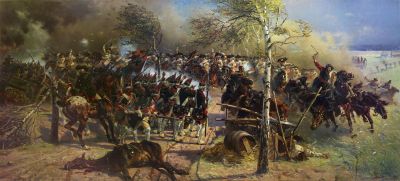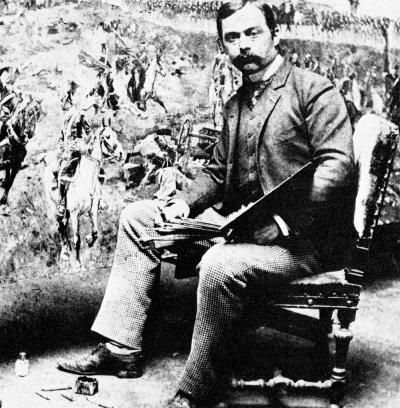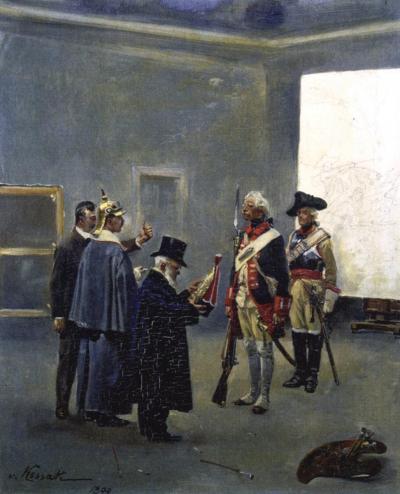Wojciech Kossak: The Battle of Zorndorf (1758), 1899

Over the following five years Kossak painted two portraits of the Kaiser on horseback, along with six battle scenes from the Seven Years War and the wars of liberation conducted by Prussia and Russia against Napoleonic rule in Europe. Kossak became increasingly friendly with the Kaiser and his wife and this led to Wilhelm receiving private invitations to the City Palace and spontaneous visits to his workshop, where he eulogised about Kossak’s battle scenes. Kossak spoke of “gracious recognition”, generous patronage and prompt payments. In Berlin he operated under the name of Adalbert Ritter von Kossak, an Austrian/Galician noble’s title.
The first picture he painted for Wilhelm was “The Royal Grenadiers near Etoges 1814”, upon which the Kaiser commissioned him in March 1898 to paint a picture portraying the glorious history of the regiment, intended to be hung in the regiment mess of the Gardes du Corps in Potsdam. The theme was the cavalry attack led by the young General Friedrich Wilhelm von Seydlitz in the Battle of Zorndorf on the 25. August 1758 during the Seven Years War. Here William succeeded in stopping the oncoming Russian army from moving into the County of Brandenburg. Kossak worked on the painting, now known as the “Battle of Zorndorf”, from September 1898 until the following April. Immediately after it was completed, the monumental portrait (it measured 2.7 x 6 metres), was displayed from May to September 1899 at the Greater Berlin Art Exhibition at the Lehrter Bahnhof. After that it was officially placed in the regiment mess in Potsdam in October 1899.
The general public learnt all about the painting not only through the exhibition in Berlin. The popular illustrated magazine “Berliner Leben. Zeitschrift für Schönheit und Kunst”, also reported on the preceding visit by the Kaiser to Kossak’s workshop to view the newly completed picture, accompanied by the painter Adolf v. Menzel and the Russian ambassador. The magazine also published two photographs commissioned by Cossack in anticipation of the visit, and reported: “His Majesty is reputed to be an extremely ardent visitor to the artist’s workshop and honours him with commissions. Indeed the Kaiser follows the creation of the art works he has ordered with passionate interest because the ideas for the great majority of them spring from his own mind. For this reason the monarch has recently conducted a number of regular conversations with the Polish painter A. v. Kossak to whom he has allotted a special workshop in the Monbijou Palace in which to paint his large-scale battle scenes. […] The two portraits of the Kaiser in the current edition of this magazine are original photos taken, with the consent of his Majesty, in the workshop of Herr v. Kossak. Adolf v. Menzel was also present at the express wish of the Kaiser […] In this case the Kaiser placed great value on Menzel’s presence because the subject of the painting was from the time of Frederick the Great, on whom Adolf v. Menzel is the major expert”.








